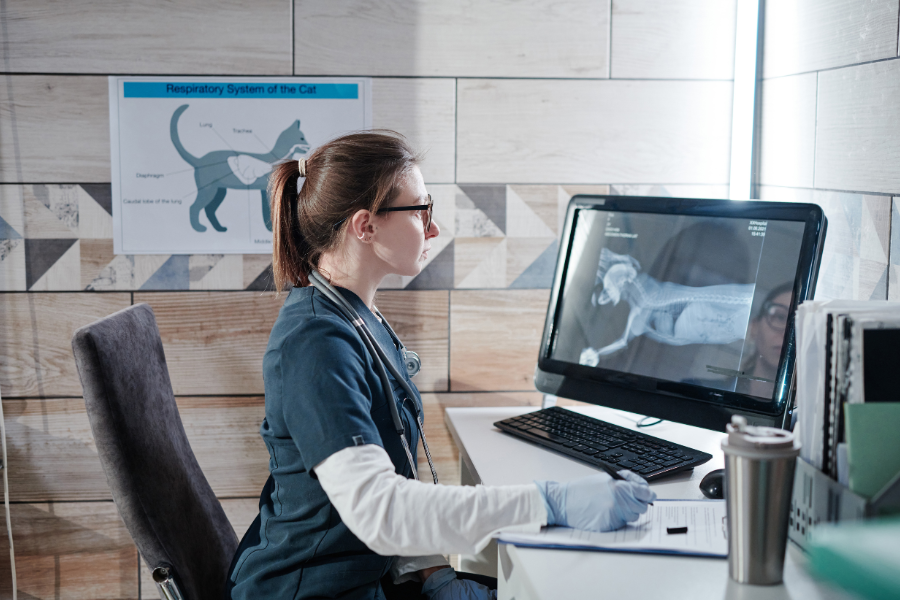While most of us spend our time focusing on current business conditions, business economists recommend thinking about the complete business cycle. This long-term planning makes it easier to maintain a strong practice, even when your local market is contracting.
‘Veterinary practices that strategically plan across the full economic cycle are better positioned to capitalize on emerging business opportunities, regardless of market condition.’
Matt Salois, Economist and VMG President
Our recent post on how to keep your practice thriving in a soft economy (article) explained the 4 phases of the business cycle, and focused on Phase C, Slower Growth (Figure 1). This post describes what to do during Phase D, Recession. During this time, wise veterinary practice owners don’t just address current challenges; they also prepare for the return of Phase A, Recovery, and Phase B, Accelerating Growth.
Surviving hard times
During Phase C, economic growth slows; when sales drop below the previous year, Phase D (Recession) begins. Whether it is caused by fewer patient visits or fewer products or services provided at each visit, your practice’s revenues take a hit. At the same time, high levels of inflation can raise costs all along your supply chain. In these conditions, your practice’s profits can quickly erode. In the worst case, it can even lose money.
How do you manage your practice through Phase D? You must thoroughly understand where your profit comes from and focus on providing profitable services, eliminating unprofitable ones, and giving every patient excellent care. This is the time to really double down on your competitive advantages and emphasize the value they bring to your clients. As VMG Senior Economist Charlotte McKay says, “While it may seem counterintuitive, veterinary practices can still grow in an economic downturn by focusing on a few key strategies.”
Avoid the pricing trap
While your first instinct may be to increase prices to cover higher costs and prop up declining revenues, it’s dangerous to assume that this strategy will always work. Clients will eventually resist paying higher prices. In a survey earlier this year, veterinarians indicated that 46% of clients were at some point unwilling or unable to pay for suggested treatments, a significant increase over 2023.2 They might choose to forego treatment, or switch to a new low-cost option, like one of Walmart’s new clinics. Instead of automatically increasing prices, emphasize your practice’s unique qualities that clients value, so that price becomes less important.
Controlling expenses
Reducing costs is the first step to maintaining profitability when your practice faces tough times. Even if you have already done so, look again at basics like inventory flows, accounts receivables, and accounts payables. VMG members can take advantage of the VMG Purchasing Program, offering discounts, rebates, and special members-only promotions from more than 60 partners who provide medications, diagnostics, nutritional products, and even practice equipment.
Just like providing the best care, cost control is part of every veterinary team member’s job. Remind everyone that free products and services are a cost to the practice; every product or service provided should be included on a client’s invoice. A written policy about providing free care for patients whose owners need financial help can make this easier. If your practice has one, review it with your team. If you don’t have this type of policy, consider writing one. Keep the content short and the language simple. If many of your clients are multilingual translate it into the other language(s) commonly spoken in your area.
Adding value with new products or services
It may seem counterintuitive, but an economic downturn could be the right time to offer clients new products or services. Practices that plan for the long term know what they might want to introduce and when. This planning is best done before hard times strike, without the pressure of needing to improve revenue streams.
When thinking about new offerings, take advantage of expertise that already exists within your team. Your new offering might be a new service, like nutritional counselling by a CVT member of the Academy of Veterinary Nutrition Technicians. Or it could be a new piece of equipment that no other practice in the area has, like the use of CO2 laser and vessel sealers in surgery offered by Dr. Travis Cerf, VMG member and owner of Veterinary Center of Hardyston in New Jersey.3 Dr. Cerf shares these important tips for designing your differentiating points:
- Conduct a careful competitor analysis. If a local competitor offers a similar service to one that you are considering, pick something else.
- Make sure your entire staff is fully behind the new offering and recommends it to clients. This is the only way to make it pay. If it’s a new piece of equipment, like his CO2 laser, train associates on it too. It shouldn’t be just your ‘toy.’
- Use social media in a meaningful way to promote your new offering. Dr. Cerf’s practice posts ‘before and after’ photos to emphasize the laser’s benefits that matter to pet owners, like less bleeding and smoother healing.
- In tight economic times, even affluent pet owners may decline elective procedures, but most people still want to try to save their pet’s life in a crisis. Become adept at dealing with common emergencies and offer that urgent care to your clients, rather than always referring them to a local specialist.3
Identify areas where you outperform other practices in the area and lean into them: Are you known for your expertise in reproduction? Market your practice to breeders. If your lead associate has champion agility dogs, reach out to other local enthusiasts and let them know you have someone who understands what their dogs need to be able to do.
Whatever you choose to introduce, do your research first. Be careful not to cannibalize an existing profitable offering. Emphasize the value you provide, whether that’s the long-term relationship built by always seeing the same doctor or special knowledge or skills that no other local practice can offer.
Taking the long view
When the economy is booming and your practice is thriving, it’s easy to sit back and enjoy your strong growth. Smart practice owners take advantage of the good times. Invest in capital expenditures that makes sense. Get closer to your clients. Save money, creating a cushion you can rely on should you need to run in the red for a short period. Create an action plan for the business cycle’s inevitable next downturn.
This is the time to make sure you understand your practice’s key performance indicators and can spot the warning signs of change. Invest the time in some long conversations with your financial advisor and practice manager about what angry economic bear could be lumbering down the road, and how you will face it.
Set long-term goals and strategies to reach them
What are your goals for the next 5 to 10 years? Just as you would have an exit strategy for selling your practice, have a ‘staying in business’ strategy for keeping it healthy. Create a formal growth plan, whether that means adding hours and staff, investing in new equipment, or even building a new hospital.
Use scenario planning
Use scenario planning to help you manage risks. Think about your business’s key performance indicators or key economic indicators. What would you do if one of them sank or surged? At what level would you trigger that action? VMG member practices often track new client visits, which decreased by almost 10% on average in 2023.4 If you’re tracking this metric, what is your target level of new clients per month? If it’s dropping, when do you need to react, and how?
Plan against the cycle
Building financial flexibility means planning against the cycle, often described as “save in the good, spend in the bad.” In good times, save as much money as you can without hindering growth. Identify areas you could cut back if necessary, or where you might find new opportunities. When bad times arrive, you’ll know what to do. Hard times are far less intimidating when you have a well-thought-out plan to deal with them.
Invest in staff
At any phase of the business cycle, upskilling your staff can improve productivity, retention, and patient care. Make sure everyone on staff has development plans to give them the skills they need to fully contribute to the business. Consider offering your entire staff financial training (LINK TO BLOG). Be open to informational interviews with potential associates and staff members at all levels, so you have a roster of people to contact when it’s time to hire.
Look at the big picture
Know the key numbers for your business. Important metrics get to the heart of where your practice makes or spends money. They can include: the percentage of new clients coming into your practice; total revenue or invoice per FTE (Full-time Equivalent) veterinarian; and EBITDA, a measure of your practice’s profitability before interest, taxes, and, and other expenses not directly related to the products and services you provide. When you understand them and know what levels indicate growth or trouble, you can react more quickly and more effectively.
Watch larger trends in your economy and local community, from state taxes and international tariffs to local job growth or contraction. Is a big new employer opening, or a long-standing one closing? Anything that affects your clients’ finances may also affect your practice.
Long-term planning for long-term success
Facing today’s economic environment and acting appropriately is much easier if you have planned for it in advance. Advance planning helps you identify the signs that conditions are about to change, so you can take early advantage of opportunities or head off potential crises.
Don’t spend hours trying to guess the next move of the practice on the other side of town. Instead, use that time to evaluate what your practice can do better. Your goal is not to outperform another practice; it’s to improve own your practice’s performance.
Building a resilient business requires that we live in today and plan for the future. Even in the face of a difficult short-term outlook, spare a little time to think like an economist. Look at where the economy is in the business cycle. If it’s on the soft side, prepare for growth. If it’s growing, prepare for soft times to come. It may feel a little upside down, but it works!
References
- ITR Economics Website. https://itreconomics.com/ Accessed 14 February 2025
- Vetwatch Sentiments website. M/A/R/C Research Survey of US pet owners and companion animal veterinarians. https://www.vetwatch.com/sentiments/ Accessed 16 December 2024.
- Dr. Travis Cerf, Veterinary Center of Hardyston. Personal communication, 23 December 2024.
- Brakke Consulting 2024 Animal Health Industry Overview. Presented 18 February 2024 at VMX, Las Vegas, NV.




